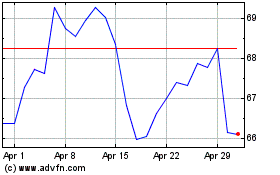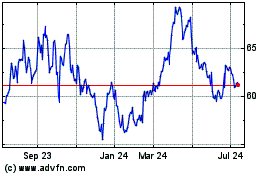By Caitlin McCabe, Avantika Chilkoti and Frances Yoon
This article is being republished as part of our daily
reproduction of WSJ.com articles that also appeared in the U.S.
print edition of The Wall Street Journal (May 7, 2020).
The S&P 500 and Dow Jones Industrial Average edged lower in
a choppy trading session Wednesday, as investors continued to try
to untangle data and corporate earnings to determine what the
economy might look like in the months ahead.
After opening modestly higher, the indexes flitted between small
gains and losses throughout most of the day. The declines
accelerated in the final hour of the session.
The S&P 500 lost 20.02 points, or 0.7%, to 2848.42. The Dow
dropped 218.45 points, or 0.9% to 23664.64.
Only the Nasdaq Composite was solidly higher for the day, driven
upward by a continued rally in technology stocks. The index rose
45.27 points, or 0.5%, to 8854.39.
Wednesday's volatility came as investors struggled to parse
widely varying data and events related to the coronavirus pandemic.
In recent days, stocks have been buoyed by optimism around the
continued lifting of stay-at-home orders. Several states have
already begun to reopen their economies and others are formulating
plans.
President Trump, in particular, has been eager to energize the
economy, saying Wednesday that the White House coronavirus task
force would focus on reopening the country and developing a
vaccine.
Still, much about the country's future remains unknown. The
number of confirmed coronavirus cases in the U.S. has climbed
beyond 1.2 million, and many have fear there could be a resurgence
of cases as life begins to return to normal. Comments from
corporate executives, meanwhile, haven't offered investors
reassurance either, as companies have continued to report massive
profit declines, dividend cuts and layoffs during first-quarter
earnings season.
Economic data look similarly grim. The nonfarm private sector in
the U.S. lost about 20.2 million jobs from March to mid-April, the
ADP National Employment Report revealed Wednesday. Losses were the
steepest among large businesses with 500 or more employees, raising
new questions about whether more pain in the markets could be
ahead.
"We're seeing data that's just off the charts," said Philip
Lawlor, managing director of global markets research at FTSE
Russell. "Has the market fully discounted [all of this]? My
suspicion is that we haven't yet reached that point."
Since the U.S. stock market bottomed March 23, equities have
largely charged upward, puzzling many economists about what an
eventual economic recovery might look like. Both the S&P 500
and Nasdaq are up week-to-date, and the Nasdaq is down just 1.3%
for the year.
The Dow, in contrast, remains down 17% in 2020.
The technology sector has helped mitigate losses this year and
continued to do so on Wednesday. Match Group jumped 9.1% after the
online-dating company said in a letter to shareholders that it had
seen a "noticeable increase" in activity among users across its
brands and geographies.
And Netflix, added 2.3%, continuing its rapid climb upward for
the year.
Meanwhile, Shares of General Motors jumped 3% after it became
the only Detroit car company to post a profit for the first
quarter.
Still, losses were broad, with nine of the S&P 500's 11
sectors reporting declines. Among individual companies that
reported earnings, Occidental Petroleum fell 13% after reporting a
first-quarter loss. The Wall Street Journal also reported that the
energy producer is exploring ways to reduce its roughly $40 billion
debt load following a historic plunge in oil prices and a recently
completed acquisition of Anadarko Petroleum.
CVS Health lost 1.3%, despite easily topping earnings
expectations. Prudential Financial also fell, dropping 7.9%, after
reporting ultralow interest rates pressured its profit on some
insurance products.
And Walt Disney, ended the day down 0.2%. The world's largest
entertainment company said the coronavirus pandemic took a $1.4
billion bite out of its earnings.
Such wide disparities across corporate earnings this spring --
coupled with dozens of companies withdrawing their guidance -- have
made it difficult for investors to gauge the health of the
economy.
"It is hard to say just how fast the economy will bounce back,"
said Patrick Spencer, managing director at U.S. investment firm
Baird. "There are so many unknowns over the length of Covid and how
consumers will behave once the economy begins to reopen."
States such as Georgia, which recently lifted stay-at-home
restrictions, could offer a helpful glimpse of how businesses and
consumers respond. Many economists will be watching to see how long
it takes companies across the U.S. to hire back the more than 30
million people who have sought unemployment benefits. Consumer
spending, which accounts for more than two-thirds of economic
activity, will also be closely monitored.
"I think the real question is, as the lockdowns ease, the doors
to the restaurants may be opening, but how many customers are going
to come in?" said Andy Sparks, MSCI's head of portfolio management
research. "There is this large amount of uncertainty hanging over
the markets' head."
In bond markets, the yield on the 10-year U.S. Treasury rose to
0.709%, from 0.656% Tuesday. Yields rise as bond prices fall.
And in commodities, Brent crude, the global benchmark, dropped
4% to $29.72 a barrel, stalling its recent gains.
In Europe, the Stoxx Europe 600 benchmark closed down 0.3%.
China's Shanghai Composite Index closed up 0.6%. Hong Kong's Hang
Seng Index rallied 1.1%.
Write to Caitlin McCabe at caitlin.mccabe@wsj.com, Avantika
Chilkoti at Avantika.Chilkoti@wsj.com and Frances Yoon at
frances.yoon@wsj.com
(END) Dow Jones Newswires
May 07, 2020 02:47 ET (06:47 GMT)
Copyright (c) 2020 Dow Jones & Company, Inc.
Occidental Petroleum (NYSE:OXY)
Historical Stock Chart
From Mar 2024 to Apr 2024

Occidental Petroleum (NYSE:OXY)
Historical Stock Chart
From Apr 2023 to Apr 2024
